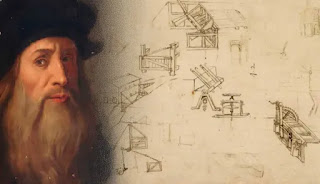Saturday, March 30, 2024
Who is Carlos Slim Helu?
Friday, March 29, 2024
The Genius of Leonardo Da Vinci
Leonardo da Vinci was one of the most renowned polymaths in history, excelling in various fields such as art, science, engineering, and anatomy. His genius lies in his remarkable ability to combine artistic creativity with scientific observation and technical innovation. Here are some key aspects of Leonardo da Vinci's genius:
Artistic Mastery: Leonardo is perhaps best known for his extraordinary artistic talents. His paintings, including the iconic "Mona Lisa" and "The Last Supper," are celebrated for their mastery of composition, perspective, and expression. His drawings, sketches, and anatomical studies also showcase his unparalleled skill in capturing the intricacies of the human form and the natural world.
Scientific Inquiry: Leonardo's curiosity extended far beyond the realm of art. He made significant contributions to various scientific fields, including anatomy, botany, geology, and physics. His detailed anatomical drawings, for example, were groundbreaking in their accuracy and understanding of human anatomy.
Engineering Innovations: Leonardo was a visionary engineer and inventor, conceptualizing ideas far ahead of his time. He designed flying machines, bridges, military weapons, and hydraulic systems, among other inventions. While many of his designs were not realized during his lifetime, they demonstrated his inventive spirit and foresight.
Observational Skills: Leonardo possessed an acute sense of observation, carefully studying the natural world and human behavior. His notebooks are filled with detailed observations, sketches, and diagrams of phenomena ranging from the flight of birds to the flow of water. His keen observational skills allowed him to make groundbreaking discoveries and innovations in various fields.
Interdisciplinary Approach: What truly sets Leonardo apart is his ability to integrate knowledge from different disciplines. He saw connections between art and science, recognizing that both were essential for understanding the world. This interdisciplinary approach enabled him to push the boundaries of knowledge and creativity, leaving a lasting impact on countless fields.
Leonardo da Vinci's genius continues to inspire and captivate people around the world, serving as a testament to the power of human intellect, creativity, and curiosity. His legacy as a Renaissance polymath remains unparalleled, making him one of the most influential figures in history.
Wednesday, March 20, 2024
Who is Ibn Taimiyyah?
Ibn Taymiyyah, also known as Taqi ad-Din Ahmad ibn Taymiyyah, was a prominent Islamic scholar and theologian born in 1263 CE in Harran, which is now in Turkey. He lived during the medieval Islamic period and is considered one of the most significant figures in Islamic thought.
Ibn Taymiyyah was known for his extensive knowledge of Islamic jurisprudence, theology, Quranic exegesis, and hadith (sayings and actions of the Prophet Muhammad). He was deeply influenced by the teachings of classical Islamic scholars, particularly the Hanbali school of jurisprudence, which emphasizes adherence to the Quran and the Hadith, as well as a strict interpretation of Islamic law.
Throughout his life, Ibn Taymiyyah engaged in theological debates and wrote numerous works on various topics, including theology, jurisprudence, spirituality, and politics. He advocated for a return to the original sources of Islam and criticized what he perceived as innovations and deviations from orthodox Islamic teachings.
Ibn Taymiyyah's ideas were often controversial, and he faced opposition from some scholars and authorities of his time due to his criticism of certain established practices and beliefs. Despite this, he gained a significant following, and his writings continue to be studied and revered by many Muslims around the world.
Ibn Taymiyyah's influence extends beyond his lifetime, with his teachings continuing to shape Islamic thought and theology to this day. He is often cited by contemporary Islamic scholars and movements, both for his theological insights and his emphasis on adherence to the foundational principles of Islam.
Friday, March 15, 2024
Summary on The Thirteenth Tribe by Arthur Koestler
"The Thirteenth Tribe" is a book written by Arthur Koestler, published in 1976. The book explores the controversial theory that Ashkenazi Jews are not descended from the ancient Israelites but rather from the Khazars, a Turkic people who converted to Judaism in the 8th century.
Key points covered in "The Thirteenth Tribe" include:
Khazar Conversion: Koestler argues that the Khazars, a semi-nomadic Turkic tribe in Central Asia, converted to Judaism around the 8th century. He suggests that this conversion was a strategic decision to avoid pressure from both Christian Byzantium and Muslim forces.
Migration to Eastern Europe: According to Koestler, after the collapse of the Khazar Empire, the Khazar Jews migrated to Eastern Europe, particularly to what is now modern-day Ukraine, Poland, and Russia. He asserts that these Khazar Jews eventually became the Ashkenazi Jews of Eastern Europe.
Genetic Evidence: Koestler points to genetic studies and historical evidence to support his theory, suggesting that the genetic makeup of Ashkenazi Jews is more closely related to other Turkic and European populations than to Middle Eastern Jews.
Controversy: "The Thirteenth Tribe" sparked considerable controversy within both the Jewish and academic communities. Critics argue that Koestler's theory lacks substantial evidence and overlooks the rich historical and cultural ties between Ashkenazi Jews and their Middle Eastern origins.
Historical Context: The book is situated within the broader context of debates surrounding Jewish identity and origins. Koestler's theory challenges traditional narratives of Jewish history and raises questions about the fluidity and complexity of ethnic and religious identities.
Overall, "The Thirteenth Tribe" presents a provocative and contentious thesis that seeks to redefine the origins of Ashkenazi Jewry. While it has generated significant interest and debate, its conclusions remain highly disputed within academic circles.
_(cropped).jpg)


